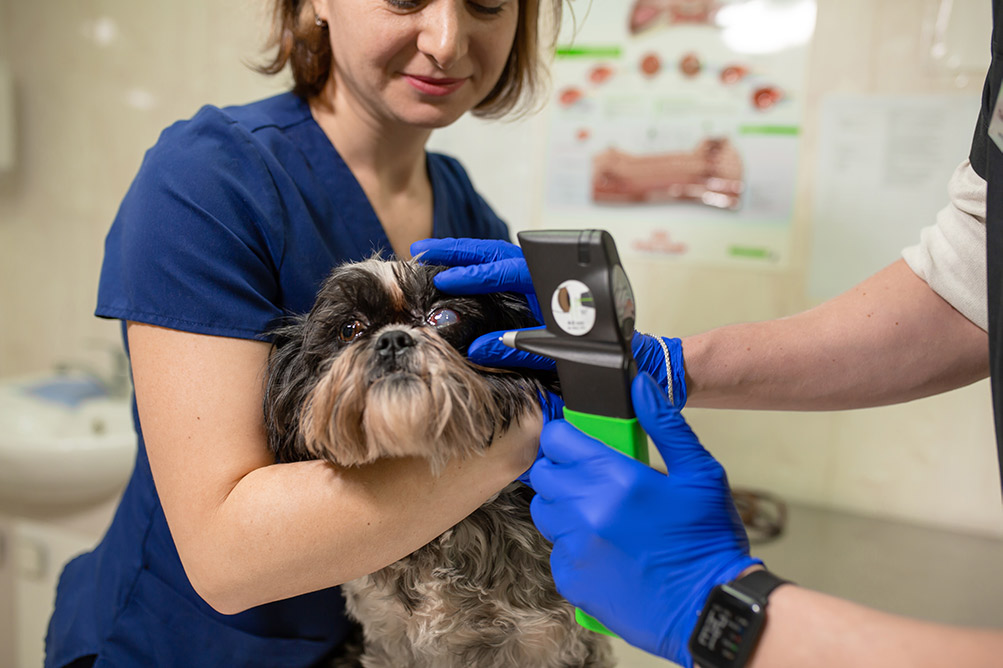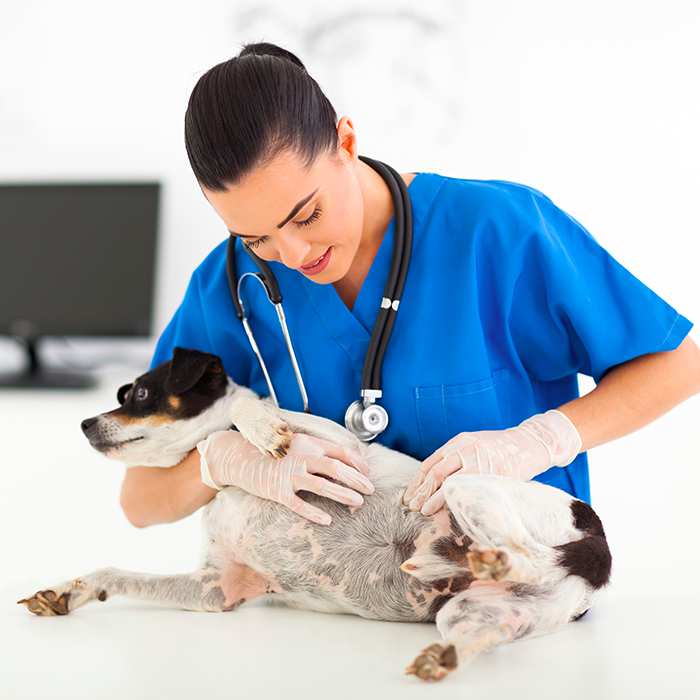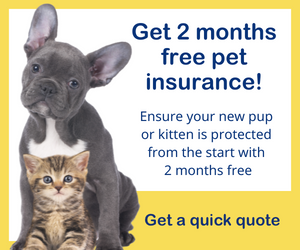Pet Insurance Costs: How much is pet insurance?
As more and more of us regard our pets as a part of the family, we expect our furry family members to be treated accordingly when they aren’t well. This mindset has spurred the continuous advancement of veterinary medicine over the last decade. As a result, veterinary expenses have risen in line with the sophistication of vet care. Because veterinary care is not subsidised by a Medicare-type system, pet insurance is increasingly becoming a necessity for pet owners to manage the rising costs of vet care.

Pet insurance is way to protect both you and your pet from unexpected vet bills. Not only does it make sense financially; it also makes sense for your pet. Pet insurance premiums can be budgeted for each month, but the peace of mind that comes with never having to weigh up the cost of vet treatment is priceless.
Bow Wow Meow offers flexible pet insurance options to suit a range of needs and budgets, and is underwritten by Petsure, Australia’s leading pet health insurer.
So how much does pet insurance cost?
Pet insurance costs vary depending on a number of factors including cover options, species, breed and age of the pet. To get a truly accurate idea, we suggest you get a quick, obligation free, pet insurance quote.
However, the real cost of pet insurance is not purely a function of the premium charged, and there are other factors that should be considered. For example, while everyday expenses such as food, vaccinations, and flea and worming treatments can be managed within the family budget, an unforeseen illness or accident can quickly reach thousands of dollars in vet bills that are more difficult to cover on the spot. This is where pet insurance can help, providing peace of mind as well as financial support and allowing you to focus on the wellbeing of your pet rather than the cost of treatment.

A better question than “How much does pet insurance cost?” may well be, “What is the cost of not having pet insurance?” The purpose of pet insurance is not just to cover the small expenses, it is to cover large, unexpected expenses that could end up costing thousands. It is these larger costs that typically cause considerable stress and worry to pet owners. When your pet is in a serious condition, pet insurance takes stress and worry out of the equation and allows you to focus on getting your pet the best possible treatment and care. The alternative is too difficult to contemplate.
A pet insurance policy with Bow Wow Meow will help ensure you can always afford to give your pet the best treatment.
- Find out more about our dog insurance options
- Find out more about our cat insurance options
- Get an instant online pet insurance quote
How are pet insurance prices calculated?
Pet Insurance companies take into account many variables that influence cost, such as:
- Species: Bow Wow Meow insures dogs and cats only. Cats are generally less risk prone and less costly to treat, and premiums tend to reflect this.
- Breed: Breed plays a significant role in pricing. As an insurer, we understand which conditions are more likely to affect certain breeds based on the historical data we have collected. This data assists in predicting the chances of claim frequency for certain conditions in each breed.
- The animal’s age: Although younger pets are more prone to accidents, older pets are more prone to illness. As a result, premiums need to be risk adjusted as your dog or cat ages.
- Where you live: The demographics of an area can affect the cost of veterinary treatments, and there are considerable discrepancies between the different states and areas within each state. This needs to be taken into account so that premiums are fairly adjusted according to the cost of vet care per area.
Is the cost of pet insurance worth it?
Once you start researching the average cost of veterinary care and the potential costs you will be faced with when treating a serious health condition, the value of pet insurance is put into perspective.
 The cost to treat health conditions affecting pets can vary depending on how severe they are, the treatment protocol recommended, and the pets’ individual response to treatments. As veterinary medicine, surgery and imaging continue to advance, treatment options for serious conditions such as tumours and cancers have advanced, and consequently so have treatment costs.
The cost to treat health conditions affecting pets can vary depending on how severe they are, the treatment protocol recommended, and the pets’ individual response to treatments. As veterinary medicine, surgery and imaging continue to advance, treatment options for serious conditions such as tumours and cancers have advanced, and consequently so have treatment costs.
Let’s take a look at the top conditions that affected dogs and cats in 2023 and how much they cost, according to data from the Pet Health Monitor 2024. Below are tables that illustrate the average and maximum veterinary costs for the most common health conditions for dogs and cats by age category.
Top 3 health conditions for dogs under 1 year in 2023*:
| Condition | Average treatment cost | Maximum treatment cost |
|---|---|---|
| Gastrointestinal disease | $661 | $25,939 |
| Skin infection / allergy | $346 | $8,414 |
| Ear Infection | $330 | $12,380 |
Top 3 health conditions for dogs aged 1-8 years in 2023*:
| Condition | Average treatment cost | Maximum treatment cost |
|---|---|---|
| Skin infection / allergy | $586 | $20,622 |
| Ear Infection | $399 | $20,654 |
| Gastrointestinal disease | $812 | $26,435 |
Top 3 health conditions for dogs over 8 years in 2023*:
| Condition | Average treatment cost | Maximum treatment cost |
|---|---|---|
| Skin infection / allergy | $601 | $10,596 |
| Arthritis | $682 | $12,387 |
| Cancer / tumours | $1,514 | $37,133 |
Top 3 health conditions for cats under 1 year in 2023*:
| Condition | Average treatment cost | Maximum treatment cost |
|---|---|---|
| Gastrointestinal disease | $530 | $9,963 |
| Eye disease | $294 | $7,823 |
| Skin infection / allergy | $270 | $4,433 |
Top 3 health conditions for cats aged 1-8 years in 2023*:
| Condition | Average treatment cost | Maximum treatment cost |
|---|---|---|
| Gastrointestinal disease | $727 | $27,061 |
| Traumatic injury | $836 | $30,990 |
| Skin infection / allergy | $398 | $9,614 |
Top 3 health conditions for cats over 8 years in 2023*:
| Condition | Average treatment cost | Maximum treatment cost |
|---|---|---|
| Gastrointestinal disease | $854 | $16,019 |
| Arthritis | $631 | $3,686 |
| Urinary tract disease | $1,589 | $16,559 |
*Based on PetSure claims data, 2023 calendar year. Reimbursement for these claims under a pet insurance policy, would be subject to limits, such as annual benefit limits or sub-limits, benefit percentage, applicable waiting periods and any applicable excess. Cover is subject to the policy terms and conditions. You should consider the relevant Product Disclosure Statement or policy wording available from the relevant provider. Please note that values calculated are based on all claims for that condition and medically related conditions in each calendar year.
Note that in many cases there is a large difference between the average cost and the maximum cost. This is often because multiple vet visits and repeated diagnostic tests are required during treatment, depending on the severity of the condition and the pet’s response to the treatment protocol. For example, some skin conditions may be uncomplicated and require only one or two visits, while others require multiple visits and longterm treatment. Therefore, the average cost may appear low, however over the course of time the cumulative total can nevertheless be quite large.
The question that you need to ask yourself is this, “If you don’t have pet insurance, would you be able to pay for an unexpected vet bill for a couple of thousand dollars?”
How do I lower the cost of pet insurance?
Pet Insurance premiums are affected by a number of factors, some of which have been outlined above.
To reduce your pet insurance costs, we suggest you consider the following options:
- Choose a lower annual limit: In most cases, policies with higher annual limits will have higher premiums.
- Adjust the benefit percentage level: Our pet insurance options allow you to choose a benefit percentage level up to 70%, 80% or 90% . The higher the benefit rate you choose, the higher the premium will be.
- Choose an annual excess: choose from our annual excess options for more control over your premium and out-of-pocket expenses.
Common Pet Insurance Exclusions
Pre-existing conditions
This will affect the pet insurance policies of dogs and cats that have a health condition prior to obtaining a policy, as that particular condition will be excluded from the pet insurance policy.
Also be aware that if an illness or condition occurs within the first 30 days of taking out a policy in which illnesses and conditions have a 30-day waiting period, then that illness or condition will also be classified a pre-existing condition.
Certain specified conditions, for example, Cruciate Ligament Disease, have a 6 month waiting period. The Cruciate Ligament waiting period may be waived if a Cruciate Ligament Exam Form is completed and signed by your vet on or after the policy commencement date, and received within 14 days of the examination date.
At Bow Wow Meow Pet Insurance, you are able to apply for a pre-existing condition waiver, provided you have had continuous cover for an 18 month period and there are no signs of that condition occurring during that 18 month period.
Ordinary day-to-day and preventative care
Our Routine Care non-insurance benefit assists you and your vet in providing for your pet’s routine care needs such as vaccinations and standard preventative visits, microchipping and flea, tick and worm control, up to a limit of $150 per year.
Our Booster Care optional benefit helps you to cover your pet for more specific treatments including specified dental conditions and specialised therapies such as behavioural and alternative therapies, up to the Booster Care limit of $2,000 per year.
Dental Illness
Our Booster Care optional benefit covers specialised dental conditions up to the Booster Care limit of $2,000 per year.
Occupational use, deliberate harm and negligence and swallowing a foreign object
If you or anyone living with you intentionally harms your pet, any injuries that occur as a result of this will not be covered by your pet insurance policy. In addition, failure to take reasonable precaution to protect your pet from situations that may result in injury or illness, such as ingestion of a hazardous substance, is also not covered.
It is also important to be aware that the policy only covers one incident per policy period of swallowing a foreign object that causes a blockage or obstruction requiring surgical or endoscopic removal.
Elective treatments
Elective treatments are treatments not considered medically essential. Essentially, anything that falls under voluntary treatment will not be covered (including desexing, though some of this is covered under Routine Care Cover).
Voluntary euthanasia also falls under this category and will not be covered (although essential euthanasia as recommended by a vet will be covered).
Pregnancy, transplants, prosthetics and other complex treatments
Pregnancy, genetic testing, cell replacement therapy (except when a blood transfusion is essential for your pet’s survival), and organ transplants are not included.
Pacemakers, artificial limbs and other prosthetics are also excluded from pet insurance cover.
Certain services and procedures
Transport or boarding expenses, ambulance fees and genetic/chromosome testing are excluded.
Other exclusions and details
The exclusions described above are a summary of many of the exclusions on a pet information policy. Please read our Pet Insurance Product Disclosure Statement for more detail and to see which exclusions apply for each policy type.
Be aware of hidden costs, sub-limits and any other restrictions
Because there is a considerable amount of detail in a product disclosure statement, it is very easy to miss some of the important information which is part of most pet insurance policies in Australia. This can often lead to a misunderstanding of policy cover, client frustration and very often a dissatisfied policy holder. The points noted in the list below are frequently not well understood when purchasing a pet insurance policy.
- Per Condition Excess: Bow Wow Meow’s pet insurance has different annual excess options for more control over your premium and out-of-pocket expenses. Depending on your choice of annual benefit limit and benefit percentage, annual excess options may include: $0, $250, or $500. This is the amount that you are required to contribute towards the cost of your claim(s) per policy period and is applied to each claim in the policy period until fully paid. The annual excess resets each time you renew.
- Co-payments: On each claim there is likely to be a co-payment. For example, if you have 70%, 80% or 90% cover, you will need to pay the co-payment balance of 30%, 20% or 10% respectively, of the total claim.
- Premiums increase each year: As the risk of illness increases with age, pet insurance premiums increase each year to adjust for this risk. This, together with other factors such as vet care cost rises, will have a significant impact on policy pricing increases over time.
- Sub-limits: Bow Wow Meow pet insurance has no sub-limits per condition.
- Waiting periods: It is important to be aware of the applicable waiting periods, for the following reasons:
- If you claim for an illness condition in the first 30 days of the policy (i.e. during the 30 day waiting period), the claim will be declined, and the illness or condition will then become a pre-existing condition and therefore excluded from future cover.
- If you claim for a cruciate ligament condition within the first 6 months of the policy period, the claim will be declined and it will become a pre-existing condition unless the Cruciate Ligament Exam Form is completed and signed by a vet on or after the policy commencement date and received within 14 days of the examination date.
It is always a good idea to read the Pet Insurance Product Disclosure Statement so that you can get a good idea of exactly what is included or excluded from cover. Once you have a good understanding of what is and isn’t covered by your policy, you will be able to get the most out of your policy and you won’t be disappointed or frustrated if a claim is not covered, as this will have been described in the product disclosure statement.
A pet insurance policy with Bow Wow Meow will help ensure you can always afford to give your pet the best treatment.
- Find out more about our dog insurance options
- Find out more about our cat insurance options
- Get an instant online pet insurance quote





